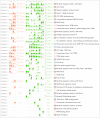Lineage-specific partitions in archaeal transcription
- PMID: 17350932
- PMCID: PMC2686387
- DOI: 10.1155/2006/629868
Lineage-specific partitions in archaeal transcription
Abstract
The phylogenetic distribution of the components comprising the transcriptional machinery in the crenarchaeal and euryarchaeal lineages of the Archaea was analyzed in a systematic manner by genome-wide profiling of transcription complements in fifteen complete archaeal genome sequences. Initially, a reference set of transcription-associated proteins (TAPs) consisting of sequences functioning in all aspects of the transcriptional process, and originating from the three domains of life, was used to query the genomes. TAP-families were detected by sequence clustering of the TAPs and their archaeal homologues, and through extensive database searching, these families were assigned a function. The phylogenetic origins of archaeal genes matching hidden Markov model profiles of protein domains associated with transcription, and those encoding the TAP-homologues, showed there is extensive lineage-specificity of proteins that function as regulators of transcription: most of these sequences are present solely in the Euryarchaeota, with nearly all of them homologous to bacterial DNA-binding proteins. Strikingly, the hidden Markov model profile searches revealed that archaeal chromatin and histone-modifying enzymes also display extensive taxon-restrictedness, both across and within the two phyla.
Figures


Similar articles
-
Phyletic Distribution and Lineage-Specific Domain Architectures of Archaeal Two-Component Signal Transduction Systems.J Bacteriol. 2018 Mar 12;200(7):e00681-17. doi: 10.1128/JB.00681-17. Print 2018 Apr 1. J Bacteriol. 2018. PMID: 29263101 Free PMC article.
-
Genome-wide identification of SF1 and SF2 helicases from archaea.Gene. 2016 Jan 15;576(1 Pt 2):214-28. doi: 10.1016/j.gene.2015.10.007. Epub 2015 Oct 8. Gene. 2016. PMID: 26456193
-
Clusters of orthologous genes for 41 archaeal genomes and implications for evolutionary genomics of archaea.Biol Direct. 2007 Nov 27;2:33. doi: 10.1186/1745-6150-2-33. Biol Direct. 2007. PMID: 18042280 Free PMC article.
-
Archaeal genomics.Curr Opin Microbiol. 1999 Oct;2(5):542-7. doi: 10.1016/s1369-5274(99)00014-4. Curr Opin Microbiol. 1999. PMID: 10508726 Review.
-
Archaeal chromatin and transcription.Mol Microbiol. 2003 May;48(3):587-98. doi: 10.1046/j.1365-2958.2003.03439.x. Mol Microbiol. 2003. PMID: 12694606 Review.
Cited by
-
The biology of thermoacidophilic archaea from the order Sulfolobales.FEMS Microbiol Rev. 2021 Aug 17;45(4):fuaa063. doi: 10.1093/femsre/fuaa063. FEMS Microbiol Rev. 2021. PMID: 33476388 Free PMC article.
-
Identification and genomic analysis of transcription factors in archaeal genomes exemplifies their functional architecture and evolutionary origin.Mol Biol Evol. 2010 Jun;27(6):1449-59. doi: 10.1093/molbev/msq033. Epub 2010 Feb 1. Mol Biol Evol. 2010. PMID: 20123795 Free PMC article.
-
Coordination of frontline defense mechanisms under severe oxidative stress.Mol Syst Biol. 2010 Jul;6:393. doi: 10.1038/msb.2010.50. Mol Syst Biol. 2010. PMID: 20664639 Free PMC article.
-
Machine learning and statistics shape a novel path in archaeal promoter annotation.BMC Bioinformatics. 2022 May 10;23(1):171. doi: 10.1186/s12859-022-04714-x. BMC Bioinformatics. 2022. PMID: 35538405 Free PMC article.
-
Genomic repertoires of DNA-binding transcription factors across the tree of life.Nucleic Acids Res. 2010 Nov;38(21):7364-77. doi: 10.1093/nar/gkq617. Epub 2010 Jul 30. Nucleic Acids Res. 2010. PMID: 20675356 Free PMC article. Review.
References
-
- Baliga N.S., Goo Y.A., Ng W.V., Hood L., Daniels C.J., Dassarma S. Is gene expression in Halobacterium NRC-1 regulated by multiple TBP and TFB transcription factors? Mol. Microbiol. 2000;36:1184–1185. - PubMed
-
- Bell S.D., Magill C.P., Jackson S.P. Basal and regulated transcription in Archaea. Biochem. Soc. Trans. 2001;29:392–395. - PubMed
Publication types
MeSH terms
Substances
LinkOut - more resources
Full Text Sources
Miscellaneous

